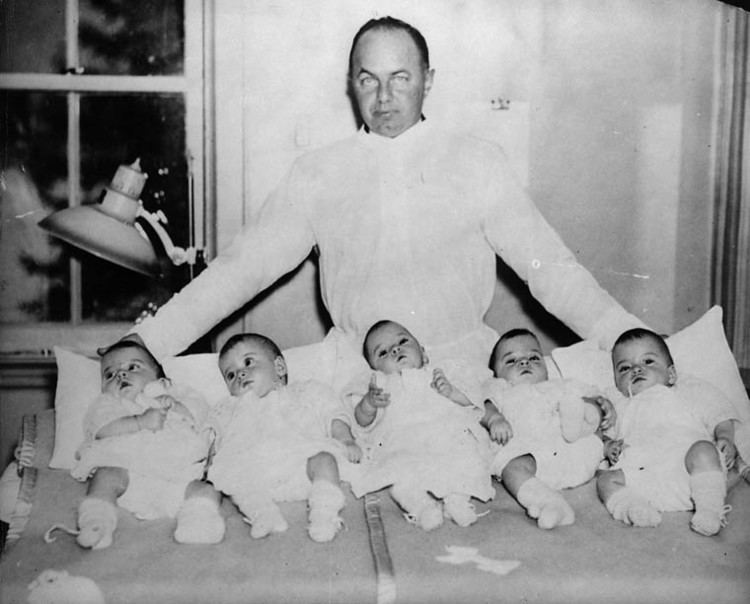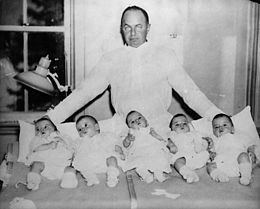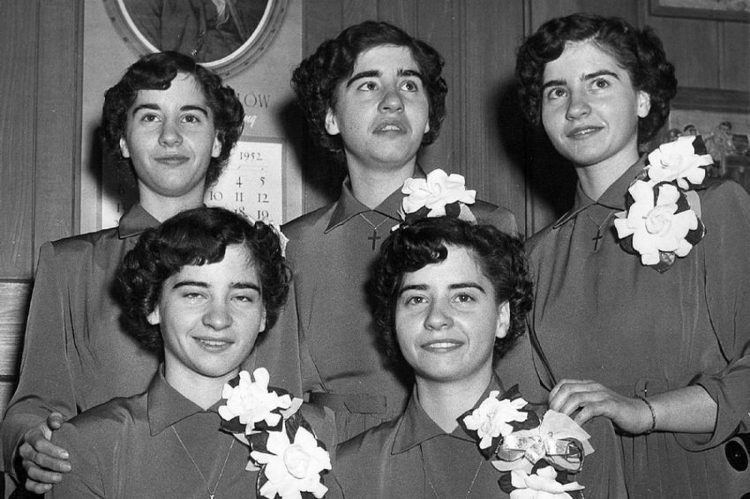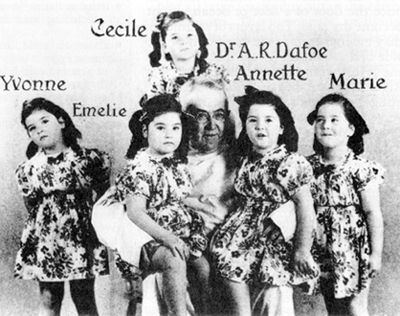Name Dionne quintuplets | ||
 | ||
The dionne quintuplets
The Dionne quintuplets ([d͡zjɔn]; born May 28, 1934) are the first quintuplets known to have survived their infancy. The identical sisters were born in Canada, just outside Callander, Ontario, near the village of Corbeil. All five survived to adulthood.
Contents
- The dionne quintuplets
- Surviving Dionne quintuplets trying to save home
- Family
- Birth
- Taken from parents
- At the Dafoe Nursery
- Film career
- Return to family
- Adult years
- Dionne Quints Museum
- In popular culture
- References

The Dionne girls were born two months premature. After four months with their family, they were made Wards of the King for the next nine years under the Dionne Quintuplets' Guardianship Act, 1935. The government and those around them began to profit by making them a significant tourist attraction in Ontario.

The identical quintuplet sisters were, in order of birth:

- Yvonne Édouilda Marie Dionne (died 2001)
- Annette Lillianne Marie Allard (living)
- Cécile Marie Émilda Langlois (living)
- Émilie Marie Jeanne Dionne (died 1954)
- Marie Reine Alma Houle (died 1970)

Surviving Dionne quintuplets trying to save home
Family

The Dionne family was headed by father Oliva-Edouard (1904–1979) and mother Elzire (Legros) Dionne (1909–1986), who married on September 15, 1925. They lived just outside Corbeil, in a farmhouse in unregistered territory. Oliva, through his father, was a descendant of Zacharie Cloutier (via Louise Cloutier 1632–1699, Charlotte Mignault 1669–1747, and Antoine Dionne 1641-1721). The Dionnes were a French-speaking farming family with five older children, Ernest (1926–1995), Rose Marie (1928–1995), Thérèse (b. 1929), Daniel (1932–1995), and Pauline (b. 1933), who was only eleven months older than the quintuplets. A sixth child, Léo (b. 1930), died of pneumonia shortly after birth.
The Dionnes also had three sons after the quintuplets: Oliva Jr. (1936–2017), Victor (1938–2007), and Claude (1946–2009).
Birth
Elzire suspected she was carrying twins, but no one was aware that quintuplets were even possible. The quintuplets were born two months premature. In 1938, the doctors had a theory that was later proven correct when genetic tests showed that the girls were identical, meaning they were created from a single egg cell. Elzire reported having had cramps in her third month and passing a strange object which may have been a sixth baby.
Dr. Allan Roy Dafoe is credited with ensuring the successful live birth of the quintuplets. Originally, he diagnosed Elzire with a "fetal abnormality". He delivered the babies with the help of two midwives, Aunt Donalda and Madame Benoit Lebel, who were summoned by Oliva Dionne in the middle of the night.
Émilie and Marie shared an embryonic sac, Annette and Yvonne shared an embryonic sac, and it is believed that Cécile shared an embryonic sac with the miscarried sixth baby. All but Émilie were later discovered to be right-handed and all but Marie had a counter-clockwise whorl in their hair.
The quintuplets' total weight at birth was 13 pounds, 6 ounces. Their individual weights and measurements were not recorded. The quintuplets were immediately wrapped in cotton sheets and old napkins, and laid in the corner of the bed. Elzire went into shock, but she recovered in two hours.
The babies were kept in a wicker basket borrowed from the neighbours, covered with heated blankets. They were brought into the kitchen and set by the open door of the stove to keep warm. One by one, they were taken out of the basket and massaged with olive oil. Every two hours for the first twenty-four, they were fed water sweetened with corn syrup. By the second day they were moved to a slightly larger laundry basket and kept warm with hot-water bottles. They were watched constantly and often had to be roused. They were then fed with "seven-twenty" formula: cow's milk, boiled water, two spoonfuls of corn syrup, and one or two drops of rum for a stimulant.
News of the unusual birth spread quickly, sparked by Oliva's brother's inquiry to the local newspaper editor about how much he would charge for an announcement of five babies at a single birth. Before long, people from all over North America were offering assistance. Individuals sent supplies and well-meant advice (a famous letter from Appalachia recommends tiny doses of burnt rye whiskey to prevent diarrhoea); one hospital sent two incubators.
Taken from parents
Oliva, already poor with five children, was approached by fair exhibitors for Chicago's Century of Progress exhibition within days of the girls' birth, seeking to put the quintuplets on display and show them to the world. (At the time it was not unusual for so-called "incubator babies" to be displayed at fairs and other exhibitions.) The parents were persuaded to agree, and although the contract was revoked before it was ever put into effect, it raised the issue of exploitation of the children.
Four months after the birth of the sisters, the Ontario government intervened and found the parents to be unfit for the quintuplets (although not for their previous children). Custody of the five babies was withdrawn from their parents by the Lieutenant Governor-in-Council, on the advice of Premier Mitchell Hepburn, in 1935. The guardianship was initially for two years. Although Oliva Dionne remained part of the guardianship, the children were put under the guidance of Dr. Dafoe and two others. The stated reason for removing the quintuplets from their parents' legal custody was to ensure their survival.
The government realised there was massive public interest in the sisters and proceeded to engender a tourist industry around them. The girls were made wards of the provincial Crown, planned until they reached the age of 18.
At the Dafoe Nursery
Across the road from their birthplace, the Dafoe Hospital and Nursery was built for the five girls and their new caregivers. The girls were moved from the farmhouse to this nursery at the end of September and lived there until they were nine years old. The compound had an outdoor playground designed to be a public observation area. It was surrounded by a covered arcade, which allowed tourists to observe the sisters behind one-way screens. The facility was funded by a Red Cross fundraiser. It was a nine-room nursery with a staff house nearby. The staff house held the three nurses and the three policemen in charge of guarding them, while a housekeeper and two maids lived in the main building with the quintuplets. The buildings were surrounded by a seven-foot barbed-wire fence. The sisters were brought to the playground for thirty minutes two or three times a day.
The Dionne sisters were constantly tested, studied, and examined, with records being taken of everything. While living at the compound, they had a somewhat rigid lifestyle. They were not required to participate in chores and were privately tutored in the same building where they lived. Cared for primarily by nurses, they had limited exposure to the world outside the boundaries of the compound except for the daily rounds of tourists, who, from the sisters' point of view, were generally heard but not seen. They also had occasional contact with their parents and siblings across the road. Every morning they dressed together in a big bathroom, had doses of orange juice and cod-liver oil, and then went to have their hair curled. They then said a prayer, a gong was sounded, and they ate breakfast in the dining room. After thirty minutes, they had to clear the table. They then went and played in the sunroom for thirty minutes, took a fifteen-minute break, and at nine o'clock had their morning inspection with Dr. Dafoe. Every month they had a different timetable of activities. They bathed every day before dinner and put on their pajamas. Dinner was served at precisely six o'clock. They then went into the quiet playroom to say their evening prayers. Each girl had a colour and a symbol to mark whatever belonged to her. Annette's colour was red and her design a maple leaf, Cecile's green and a turkey. Emilie had white and a tulip, Marie blue and a teddy bear, and Yvonne pink and a bluebird.
Approximately 6,000 people per day visited the observation gallery that surrounded the outdoor playground to view the Dionne sisters. Ample parking was provided and almost 3,000,000 people walked through the gallery between 1936 and 1943. Oliva Dionne ran a souvenir shop and a concession store opposite the nursery and the area acquired the name "Quintland". The souvenirs, picturing the five sisters, included autographs and framed photographs, spoons, cups, plates, plaques, candy bars, books, postcards and dolls. Oliva also sold stones from the Dionne farm that were supposed to have a magical power of fertility. Midwives Madame LeGros and Madame LeBelle also opened their own souvenir and dining stand. In 1934, the quintuplets brought in about $1 million and attracted about $51 million in total tourist revenue to Ontario. Quintland became Ontario's biggest tourist attraction of the era, surpassing the Canadian side of Niagara Falls. It was only rivaled by Radio City Music Hall, Mount Vernon, and Gettysburg in the United States. Hollywood stars who came to Callander to visit the Quints included Clark Gable, James Stewart, Bette Davis, James Cagney, and Mae West. Amelia Earhart also visited Callander just six weeks before her ill-fated flight in 1937.
The sisters, their likenesses and images, along with Dr. Dafoe, were used to publicize commercial products including Karo corn syrup and Quaker Oats. They increased the sales of condensed milk, toothpaste, disinfectant, and many other products through their promotions.
Film career
The Dionne girls starred in three Hollywood feature films, which were essentially fictionalised versions of their story. They played the 'Wyatt Quintuplets' in all three films:
In the first two films, the Dionne quintuplets didn't so much act as simply appear. Their scenes were filmed at Quintland in Callendar, and largely consisted of them playing and interacting with each other, as one would expect of normal 2- and 4-year-old children. Both films concentrated more on telling the (fictionalized) story of the heroic doctor who delivered the Wyatts and took care of them, than it did on the Wyatt quintuplets themselves.
The Dionne quintuplets also appeared in numerous newsreels and a short documentary film called Five Times Five in 1939. This film was nominated for an Oscar in 1940. In 1942, they appeared in one of James A. Fitzpatrick's Traveltalks Land of the Quintuplets shortly before they were returned to their parents. In 1998, the three surviving sisters, Cécile, Annette and Yvonne, participated in an hour-long documentary, "Full Circle: The Untold Story of the Dionne Quintuplets", written and directed by Maya Gallus, and broadcast on the CBC documentary series Life & Times.
Return to family
In November 1943, the Dionne parents won back custody of the sisters. The entire family moved into a newly built house within walking distance of Quintland. The yellow brick, 20-room mansion was paid for out of the quintuplets' fund. The home had many amenities that were considered luxuries at the time, including telephones, electricity and hot water and was nicknamed "The Big House". The building is now a retirement home.
The nursery was eventually converted into an accredited school house where the sisters finished their secondary education along with ten girls from the area who were chosen to attend. In later years, it was used by the Recluses of Corbeil as a convent.
While the parents claimed that they wished to integrate the quintuplets into the family, the sisters frequently travelled to perform at various functions, still dressed identically. According to the accounts of the surviving sisters, the parents often treated them at home as a five-part unit, and frequently lectured them about the trouble they had caused the family by existing. They were sometimes denied privileges the other children received, and were more strictly disciplined and punished. They also received a heavier share of the housework and farmwork. They were unaware for many years that the lavish house, the expensive food and the series of cars the family enjoyed were paid for with money they themselves had earned.
In particular, Oliva Dionne was resentful and suspicious of outsiders as a result of his having lost custody of the girls. In 1995, the three surviving sisters alleged that their father had sexually abused them during their teenaged years.
Adult years
The quintuplets left the family home upon turning 18 years old in 1952 and had little contact with their parents afterwards. Three went on to marry and have children: Marie had two daughters, Annette three sons, and Cécile five children, including one who died in infancy and twins Bruno and Bertrand. Émilie devoted her brief life to becoming a nun. Yvonne finished nursing school before turning to sculpting, then later becoming a librarian. Émilie died at the age of 20 as a result of a seizure. She had a series of seizures while she was a postulant at a convent and had asked not to be left unattended, but the nun who was supposed to be watching her thought she was asleep and went to Mass. Émilie had another seizure, rolled onto her belly and, unable to raise her face from her pillow, accidentally suffocated.
In 1970, Marie was living alone in an apartment and her sisters were worried after not hearing from her in several days. Her doctor went to her home and found her in bed, having been dead for days. Her estranged husband quickly reported to the media that there had been a blood clot in her brain.
Annette and Cécile both eventually divorced and by the 1990s, the three surviving sisters lived together in the Montreal suburb of Saint-Bruno-de-Montarville.
In 1965, author James Brough wrote a book, in cooperation with the then four surviving sisters, called We Were Five. Pierre Berton published a biography called The Dionne Years: A Thirties Melodrama in 1977 and narrated a 1978 National Film Board of Canada documentary. John Nihmey and Stuart Foxman published the fictional Time of Their Lives — The Dionne Tragedy in 1986. Nihmey and Foxman's book was the basis for the 1994 TV miniseries Million Dollar Babies (1994), produced by CBC Television and CBS Television and starring Beau Bridges, Roy Dupuis and Céline Bonnier.
In 1997, the three surviving sisters wrote an open letter to the parents of the McCaughey septuplets, warning against allowing too much publicity for the children. The letter read:
Dear Bobbi and Kenny,
If we emerge momentarily from the privacy we have sought all our adult lives, it is only to send a message to the McCaughey family. We three would like you to know we feel a natural affinity and tenderness for your children. We hope your children receive more respect than we did. Their fate should be no different from that of other children. Multiple births should not be confused with entertainment, nor should they be an opportunity to sell products.
Our lives have been ruined by the exploitation we suffered at the hands of the government of Ontario, our place of birth. We were displayed as a curiosity three times a day for millions of tourists. To this day we receive letters from all over the world. To all those who have expressed their support in light of the abuse we have endured, we say thank you. And to those who would seek to exploit the growing fame of these children, we say beware.
We sincerely hope a lesson will be learned from examining how our lives were forever altered by our childhood experience. If this letter changes the course of events for these newborns, then perhaps our lives will have served a higher purpose.
Sincerely, Annette, Cécile and Yvonne Dionne
In 1998, the sisters reached a $2.8 million settlement with the Ontario government as compensation for their exploitation.
As of December 2014 there are two surviving sisters, Annette and Cécile. Yvonne died in 2001.
Dionne Quints Museum
A sibling of the quintuplets was the first to open the Dionne home as a museum. The original family homestead was moved around 1960 to a location on Highway 11B (near the present Clarion Resort), and again in 1985 to North Bay and converted into the non-profit Dionne Quintuplets Museum. The museum is located at the intersection of Highway 11 and the Trans Canada Highway and features many artifacts from the quints' early days and their growing years. As of October, 2016, the museum is now closed, and the city of North Bay is considering selling the building as surplus, though a petition is being circulated by citizens to have it designated and preserved as a historical structure. In 2017, plans surfaced for the city to sell the building, and relocate it to a fairground in the village of Sundridge 75 km south of North Bay.
In popular culture
References to the quintuplets appear in the Three Stooges' shorts False Alarms (1936), and Oily to Bed, Oily to Rise (1939), Will Hay's "Oh, Mr Porter!" (1937), the Marx Brothers film A Night at the Opera (1935), the screwball comedy My Man Godfrey (1936), James A. Fitzpatrick's Traveltalks short "Land of the Quintuplets" (1942), Preston Sturges's The Miracle of Morgan's Creek (1944), Agatha Christie's The Adventure of the Cheap Flat and Carson McCullers's The Heart is a Lonely Hunter. The quintuplets are referred to in the song "Look Out for Mr. Stork" in the Disney movie Dumbo (1941). The name Dionne was mentioned in several Warner Brothers' Looney Tunes cartoons dealing with the stork and requests for babies ("Mr. Dionne! Please!"). They were also loosely parodied in the South Park episode "Quintuplets 2000"; though the sisters featured on the show are Romanian, their treatment by the South Park main characters, their father, and their government mirrors the Dionne quintuplets' situation. The twins were also referenced in the 1988 television comedy film "Ollie Hopnoodles Haven of Bliss" written by Jean Shepherd and directed by Dick Bartlett, based on the 1968 short story by Shepherd where 5 cabins on Clear Lake in Northern Michigan were named after them.
Canadian mystery writer Louise Penny said the fictional Ouellet quintuplets in her book How The Light Gets In "were certainly inspired by the Dionne girls".
In 'The Big Sleep'(1939), his first novel, Raymond Chandler mentions protagonist Philip Marlowe having a 'Quins calendar.' These were extremely popular at the time due to the novelty of quintuplets.
Stephen Sondheim referenced the quintuplets in his song "I'm Still Here" from the musical Follies with the line "I got through Abie's Irish Rose, five Dionne babies, Major Bowes ...".
In the television series M*A*S*H (season 9, episode 9, "Taking the Fifth"), Hawkeye Pierce comments on Charles Winchester's five bottles of expensive French red wine: "Five bottles? You could have your way with the Dionne Quintuplets."
